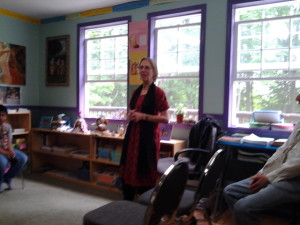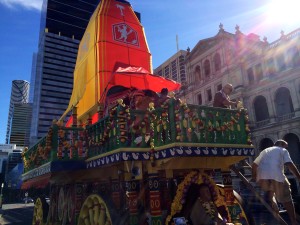 by Jai Sita Rani Devi Dasi SJMKL - Snana Yatra June 2014
by Jai Sita Rani Devi Dasi SJMKL - Snana Yatra June 2014 SJMKL – Snana Yatra June 2014
SJMKL – Snana Yatra June 2014
→ ISKCON Malaysia Photos
TOVP Canada Team To Promote TOVP In Canada
- TOVP.org
As the devotional ecstacy of building and completing the TOVP increases like the flood of love of God, devotees worldwide are coming forward to assist with promotion and fundraising.
Officially formed under the banner of the Toronto, Ontario temple with the guidance and inspiration of His Holiness Bhaktimarga Swami, the TOVP Canada Team has begun moving forward, spreading the glories of the TOVP and helping to raise funds for its completion by 2022. Due to regional laws and regulations, the fundraising will focus on specific items for the TOVP, the first of which will be a highly advanced and powerful Lightning Arrester System (see below for description) costing around $100,000. With this new initiative, Canadian donors will now also be able to receive a tax-deductible receipt for their donations.
For more information and to donate, contact Rajasuya das at: *protected email*.
If you are an ISKCON leader, temple president, etc. and also feel inspired to help fulfill this desire of Srila Prabhupada in your community on an ongoing basis, please contact Vraja Vilas das at: *protected email*.
From Wikipedia:
A lightning arrester is a device used on electrical power systems and telecommunications systems to protect the insulation and conductors of the system from the damaging effects of lightning. The typical lightning arrester has a high-voltage terminal and a ground terminal. When a lightning surge (or switching surge, which is very similar) travels along the power line to the arrester, the current from the surge is diverted through the arrestor, in most cases to earth.
In telegraphy and telephony, a lightning arrestor is placed where wires enter a structure, preventing damage to electronic instruments within and ensuring the safety of individuals near them. Smaller versions of lightning arresters, also called surge protectors, are devices that are connected between each electrical conductor in power and communications systems and the Earth. These prevent the flow of the normal power or signal currents to ground, but provide a path over which high-voltage lightning current flows, bypassing the connected equipment. Their purpose is to limit the rise in voltage when a communications or power line is struck by lightning or is near to a lightning strike.
The post TOVP Canada Team To Promote TOVP In Canada appeared first on Temple of the Vedic Planetarium.
Fire ceremony in ISKCON New Govardhana – Sri Sri Radha Govardhanadhari (Album 16 photos)
→ Dandavats.com
 Situated in the beautiful Tweed Valley in far northern New South Wales, about ten kilometres from Murwillumbah, the Hare Krishna farming community, New Govardhana, embodies this yearning for a gentler, simpler way of life. Situated near the foot of the impressive Mount Warning and surrounded by lush rainforest, banana plantations and dairy farms, the farm is a beautiful, magical place, well suited to a life of introspection and meditation.
Read more ›
Situated in the beautiful Tweed Valley in far northern New South Wales, about ten kilometres from Murwillumbah, the Hare Krishna farming community, New Govardhana, embodies this yearning for a gentler, simpler way of life. Situated near the foot of the impressive Mount Warning and surrounded by lush rainforest, banana plantations and dairy farms, the farm is a beautiful, magical place, well suited to a life of introspection and meditation.
Read more › Lagos early morning Harinam (Album 22 photos)
→ Dandavats.com
 Lord Krishna said to Arjuna, 'O Arjuna! Listen attentively. When the living entity chants My name, whether out of devotion or indifference, I never forget this act. It remains always close to My heart. There is now vow like chanting the holy name, no knowledge superior to It, no meditation which comes anywhere near it, and it gives the highest result. No penance is equal to it, and nothing is as potent or powerful as the holy name Read more ›
Lord Krishna said to Arjuna, 'O Arjuna! Listen attentively. When the living entity chants My name, whether out of devotion or indifference, I never forget this act. It remains always close to My heart. There is now vow like chanting the holy name, no knowledge superior to It, no meditation which comes anywhere near it, and it gives the highest result. No penance is equal to it, and nothing is as potent or powerful as the holy name Read more › Making yoga into a lifestyle starting with cleanliness and eating habits (Part 1)
→ SivaramaSwami.com
Friday’s talk in Istanbul.
The post Making yoga into a lifestyle starting with cleanliness and eating habits (Part 1) appeared first on SivaramaSwami.com.
The 27th Quality
→ Mahavishnu Swami
ISKCON devotees participate in the FIFA Fan Fest, during the opening of the Football World Cup of São Paulo (Album 46 photos)
→ Dandavats.com
 With the presence of HH Bhakti Dhira Damodar Swami and HH Bhakti Narasimha Swami. “The supremely potent holy name is equal in every respect to the Supreme Lord Krishna Himself, because Lord Krishna has invested the holy name with all of His potencies. Krishna has collected the spiritual results accrued by charity, austerity, penance, pilgrimage, karma-kanda rituals offered to the demigods, rajasuya-yajna, asvamedha-yajna, knowledge of self-realisation and so on infused them into His holy name to make It absolutely powerful. (Skanda Purana) Read more ›
With the presence of HH Bhakti Dhira Damodar Swami and HH Bhakti Narasimha Swami. “The supremely potent holy name is equal in every respect to the Supreme Lord Krishna Himself, because Lord Krishna has invested the holy name with all of His potencies. Krishna has collected the spiritual results accrued by charity, austerity, penance, pilgrimage, karma-kanda rituals offered to the demigods, rajasuya-yajna, asvamedha-yajna, knowledge of self-realisation and so on infused them into His holy name to make It absolutely powerful. (Skanda Purana) Read more › Harinama in New York city’s subway (Album 6 photos)
→ Dandavats.com
 Anyone who chants Lord Krishna's holy name is to be worshipped like a guru without considering that such a person is a woman, a sudra, a pukkasa, a yavana or of even lower birth. Read more ›
Anyone who chants Lord Krishna's holy name is to be worshipped like a guru without considering that such a person is a woman, a sudra, a pukkasa, a yavana or of even lower birth. Read more › New Vrindaban’s Home School Co-op Year End Party
→ New Vrindaban Brijabasi Spirit
Gopal’s Garden Home School Co-op End-of-the-Year Party
By Lilasuka dasi
“Why did Krsna ask, ‘Which Brahma?’”
This question came from a puzzled Lord Brahma, played by nine year old Josh Fintel, during the dramatic reading of Sankirtan das’s play Which Brahma? at the end of the year school party for Gopal’s Garden.
The students at Gopal’s Garden Home School Co-op ended another school year with some very fine presentations. The recited their five favorite Bhagavad Gita verses by heart; then they each read their favorite story out of many stories that they themselves had written throughout the school year, and finally, they performed the dramatic reading Which Brahma?.
Their audience, made up of parents, teachers and interested residents of NV, were delighted at the entertainment, and impressed at the level of education of the kids.
Veteran teacher, Ruci dasi, acknowledged each and every one of her students for his or her individual strengths and interests.
“If you have any questions about killer whales, just ask Josh – he did a lot of research and is expert in the subject! He’ll be ten years old in a few weeks.”
“The nine year old twins, Ram and Shyam, are both such willing and eager helpers. This party wouldn’t have come together if they hadn’t come down early to clean and vacuum in here.”
“Brinda, who is now 11 years old, is a poet. She’s an artist and a writer. She’s amazingly talented, as are all the kids!”
“Seven year old Jacob could hardly speak English when he first came to the school, and now he’s got an amazing grasp of both reading AND writing in English. He’s curious about everything around him and Jacob loves to learn.
“Jacob’s older sister, 12 year old Shemaella, is a thoughtful and caring girl who is also a creative artist. She brings a lot of sensitivity to her art and writing.”
We took the opportunity to interview Brinda, who is going to 7th grade next year.
“This school has a very good environment. It’s spiritual, plus the work is more individualized than in public school. We have a one on one relationship with the teacher, which is great. I mean, it’s not that everyone has to do the same lesson, that’s easy for some and very hard for others. The level of the lessons are just perfect for you.
Like, last year I had a spelling program, and if you don’t finish it in one year it’s ok, you just finish it next year. Or, if you can finish it before the year is up, that’s ok too. You go at your own pace. My older sister Visakha, who used to go to this school, was saying that this kind of teaching is good for all students, no matter what level you’re at. She says that she learned more when she was here than when she spent this last year in public school.”
Brnda doesn’t feel she’s missing anything by not going to public school.
“Art is one of my favorite things, and Krsna Bhava is a really good art teacher,” claims Brnda.
Shyam, a very polite and respectful boy, was born in New Vrindaban nine years ago.
He relates, “I was here at Mother Ruci’s school for five months this year. And what I appreciate most is that my teacher, Mother Ruci, is a Prabhupada disciple! My favorite subject here is the kirtan and the Bhagavad Gita classes.”
Any guest to the school will agree that it’s always a treat to visit Gopal’s Garden Home School Co-op, and see the refreshing faces of the talented students and their dedicated teacher.
Harinama in Tel Aviv, Israel (Album 16 photos)
→ Dandavats.com
 Ritualistic religious practices like yajïa, charity, sacred baths and chanting of Vedic hymns are all regulated by rules of times, cleanliness, etc. To consider that the chanting of the holy name is subject to the same restrictions is a gross blunder. There are no hard and fast rules for chanting. Therefore, everyone chant Lord Krishna's Name at all times. Read more ›
Ritualistic religious practices like yajïa, charity, sacred baths and chanting of Vedic hymns are all regulated by rules of times, cleanliness, etc. To consider that the chanting of the holy name is subject to the same restrictions is a gross blunder. There are no hard and fast rules for chanting. Therefore, everyone chant Lord Krishna's Name at all times. Read more › 12 June’14 Sringar Darshan at ISKCON Juhu
→ Gouranga TV - The Hare Krishna video collection
12 June’14 Sringar Darshan at ISKCON Juhu
Gita 14.28 – The holy name takes us out of the shackle of the modes
→ The Spiritual Scientist
Maturity means to not let our emotionality interfere with our responsibility
→ The Spiritual Scientist
In our fast-paced, want-filled culture, it’s easy to get stressed out and suffer emotional breakdowns. Perhaps the emotion most likely to disrupt the lives of most people today is anxiety.
The whole process of becoming mature centers on becoming effective in managing our emotions. Babies are governed by their emotions – if they feel pain or anger or fear, they burst out into tears. As they grow up, they learn to better regulate their emotions. Or at least they are expected to.
While we adults don’t usually cry when things don’t go our way, we may still become overwhelmed by emotions such as worry, fury or self-pity. Worry may make us want to quit and forget the whole thing. Or fury may want us to hit out at someone, something, anyone, anything. Or self-pity may make us want to wallow in self-martyrdom, feeling sorry for ourselves, attracting attention through some desperate act of self-destruction.
The Bhagavad-gita helps us understand that we are far bigger than our circumstances. No matter how imposing they seem to be, they are ephemeral, whereas we are eternal.
Such emotion-driven responses usually make things worse. To improve things, we need responses that take into account our emotions, but don’t let them be the only thing in the account. The ability to respond thus is the essence of maturity.
While some of us may have better mastery over our emotions than others, we all can benefit from greater maturity. Gita wisdom helps enhance our maturity by providing a solid spiritual foundation.
The Bhagavad-gita helps us understand that we are far bigger than our circumstances. No matter how imposing they seem to be, they are ephemeral, whereas we are eternal. We are spiritual beings who can access the omnipotence of God by activating our latent power of devotion. Through metaphysical contemplation and devotional meditation, we gain glimpses of a transcendental terra firma, an arena that is forever beyond the anxiety-inducing changes of the world. By incorporating contemplation and meditation into our daily routine, we ground ourselves in spiritual reality, thereby enabling us to deal calmly and resourcefully with the changes inevitable at the outer level. The more we realize our spiritual indestructibility and our divine connectivity, the more we can manage our emotionality intelligently without letting it interfere with our responsibility.
The empowerment available through spiritual wisdom is demonstrated in the Gita through the example of its original student: Arjuna. At the start of the Gita (01.29), he is on the verge of an emotional breakdown, not even being able to hold his bow. But by the end of the Gita (18.73), he has regained his perspective and composure – and is ready for whatever challenge life sends his way.
Gita wisdom stands ready to offer us all similar spiritual empowerment.
Mahabharata Characters 26 – Yudhisthira 04 – The Pandavas dishonoured and dispossessed
→ The Spiritual Scientist
This talk is a part of the "Fascinating Mahabharata Characters" series. To know more about this course, please visit: bhakticourses.com
Prabhupada Letters :: Anthology 2014-06-14 02:30:00 →
Prabhupada Letters :: 1972
If we concede that scripture doesn’t contain literal report of conversations then where will the erosion of scriptural authority end?
→ The Spiritual Scientist
Are science and spirituality at war with each other?
→ The Spiritual Scientist
Why are certain important verses quoted by acharyas not found in the scriptures?
→ The Spiritual Scientist
Devotee-scholars' research is uncovering the presence in scripture of many verses whose sources were earlier unknown or debated. One excellent sample of such scholarship is this document compiled by a devotee-scholar and friend Hari Parshad Prabhu:
Prabhupada verses - sources found by Hari Parshad P
Specific reference to verses about Mayavada:
mayavadam asac chastram (sastram) pracchannam bauddham ucyate mayaiva kathyate devi kalau brahmana rupina
Are chanting praying and meditation the same?
→ The Spiritual Scientist
Why do some scriptures declare other gods to be Supreme?
→ The Spiritual Scientist
Are the Puranas unreliable because they have so many different versions?
→ The Spiritual Scientist
Prabhupada quotes largely from the Puranas so how can we show that our sampradaya is based on shruti?
→ The Spiritual Scientist
I was born in another sampradaya, but became introduced to seriously bhakti through ISKCON. Which sampradaya should I follow?
→ The Spiritual Scientist
Why do insubstantial religious groups spread extensively and pure saints remain unknown?
→ The Spiritual Scientist
Brisbane Rathayatra
→ Ramai Swami
Lord Jagannatha’s Rathayatra was celebrated in central Brisbane, after many years absence, using the big Rathayatra cart from New Govardhana. This year the devotees were able to secure a permit from the City Council for the parade and use of the town hall square afterwards.
Sincerely Try To Improve
→ Japa Group
Mirror, mirror on the wall, who is the most spiritual of all?
→ KKSBlog
(Kadamba Kanana Swami, 09 May 2014, Bhaktivedanta Manor, England, Srimad-Bhagavatam 8.23.3-6)
Prahlad Maharaj said to the Lord, “You are such a kind personality, you have kindly promised to protect us – the demons!”
How nice is Prahlad, to see himself like that. Are we seeing ourselves like that? Or when we are reading the sixteenth chapter of Bhagavad-gita and the first few verses that describe the devotees, then we are like, “That is us,” and the rest of the chapter about the demons, “These are the neighbours.” Is that how we read the sixteenth chapter? Or are we reading the sixteenth chapter by holding it up as a mirror and reflecting, “How much of this is still to some degree present in me?”
Unless we are prepared to read the Bhagavatam, read the scripture in that introspective way; unless we are ready to question ourselves; and unless we are ready to have that mood of seeing ourselves as fallen, how can we be ready to improve ourselves?
https://www.facebook.com/photo.php?fbid=10151080397957055&set=a.1015040340441705…
→ Mahavishnu Swami

Mobile Uploads
The 27th quality....After giving a lecture on the 26 qualities of a Vaishnava in Boston Srila Prabhupada said actually there is a 27th quality. The Devotees looked anxiously in askance waiting for the revelation of the 27th quality of a Vaishnava. Srila Prabhupada looked at all the devotees and said with a straight face "you have to be a little crazy to be a devotee." Then he smiled and laughed a little. I always felt the 27th quality explained a lot...<3 HH. Bhagavat Maharaja Continue reading
…at Matchless Gifts now…
→ Mahavishnu Swami
Jagannath Snaan yatra @ ISKCON Baroda (Album 273 photos)
→ Dandavats.com
 Pictures of the snaan yatra in the garden in front of the Sri Sri Radha Shyamsundar Mandir at Iskcon Baroda were taken by Vaman Das, earlier today, Jyesht Purnima, June 13, 2014 Read more ›
Pictures of the snaan yatra in the garden in front of the Sri Sri Radha Shyamsundar Mandir at Iskcon Baroda were taken by Vaman Das, earlier today, Jyesht Purnima, June 13, 2014 Read more › Celebrating Russia Day the vaishnava way! (Album 15 photos)
→ Dandavats.com
 Indradyumna Swami: Yesterday Russia celebrated, Russia Day, a national holiday. Taking advantage of the occasion devotees in Moscow held a festival to celebrate their goal of creating 100 Nama Hatta centers throughout the greater city. There are 7,000 devotees in and around Moscow. May Srila Prabhupada be ever glorified! Read more ›
Indradyumna Swami: Yesterday Russia celebrated, Russia Day, a national holiday. Taking advantage of the occasion devotees in Moscow held a festival to celebrate their goal of creating 100 Nama Hatta centers throughout the greater city. There are 7,000 devotees in and around Moscow. May Srila Prabhupada be ever glorified! Read more › The biggest altar of Iskcon is being manifested in Mayapur! (Album 4 photos)
→ Dandavats.com
 Here you can see the majestic size of the Temple of the Vedic Planetarium's new altar. Please help be a part of history, and donate for the construction of this work of art. Read more ›
Here you can see the majestic size of the Temple of the Vedic Planetarium's new altar. Please help be a part of history, and donate for the construction of this work of art. Read more › Germany retreat with Bhakti Vijnana Goswami (Album 14 photos)
→ Dandavats.com
 Taken in Walthersdorf, Sachsen, Germany Read more ›
Taken in Walthersdorf, Sachsen, Germany Read more › ISKCON Disciples Course – Broadcast!
→ The Toronto Hare Krishna Temple!
 The ISKCON Disciples Course, being presented from Friday, June 13 - Tuesday, June 17, will be broadcast on our channel (Toronto) on Mayapur.tv!
The ISKCON Disciples Course, being presented from Friday, June 13 - Tuesday, June 17, will be broadcast on our channel (Toronto) on Mayapur.tv!The broadcast will begin at 6:00pm.
Please stay tuned to this post for any further updates.
New Vrindaban Daily darsan @ June 12, 2014.
→ New Vrindaban Brijabasi Spirit
Ah! In Vrndavana Forest all the animals, birds, trees, vines and countless other living entities, who are all very sweetly beautiful and as splendid as gold, have now become stunned by drinking the maddeningly sweet nectar of the bliss of great transcendental love. Ah! Induced by all of them, the most enchanting, priceless teenage treasure has now appeared before me.
Source : Nectarean Glories of Sri Vrindavana-dhama by Srila Prabodhananda Sarasvati Thakura, Sataka-2, Text-60, Translation.]
Wednesday, June 11th, 2014
→ The Walking Monk
Relentless Highway
“The highway is relentless here,” said Larry, a resident from the city of Trail. Karuna and I spent the major portion of the day seeking alternatives to the Crowsnest Pass – Highway 3B which runs through Trail. Larry, whose house we stumbled upon after being pleasantly surprised by his OM insignia at the end of his driveway, made his remark about the road and his experience. If he were a motorist, you’d find the drive through this town a grinding ordeal as the road snakes along and climbs a mountain. And the speed of traffic? I was reminded of the lyrics by that old Sonny and Cher song, “The cars keep a movin’ faster all the time.”
The alternative routes we took to circumvent the mad highway were:
1) The neglected Wagon Road 800 (The old gold rush trail).
2) The suburban street zigzagging which people call switch-backing.
3) The very informal half baked trail along a steep slope that angles into the Columbia River
Other highlights of the day:
1) Daruka, Our support driver, purchased a 21 speed mountain bike in mint condition for $40 to be used in our pedestrian service.
2) A flyer circulating in the town of Salmo was promotion for two presentations at the SVYCC for mantra meditation and a Tales From Trails at the Salmo Library.
3) Our experience walking through Trail, BC, convinced us that this city take a more serious look at its name and provide the necessary.
Here’s how the flyer for Salmo reads:
Don’t miss this amazing opportunity to meet THE WALKING MONK
The people! The wildlife! The beauty! The oddities!
Always engaging and enthusiastic, this jolly swami gives talks and takes questions about his insightful and often breathtaking adventures across our great nation as he shares his ‘Tails From Trails’, and a bonus mantra mediation.
May the Source be with you!
27 KM
Off to Istanbul
→ SivaramaSwami.com
The post Off to Istanbul appeared first on SivaramaSwami.com.
Duties and Tests
→ HH Bhakti Caitanya Swami
Devotees “Hungry to Hear” at Festival of Inspiration in New Vrindaban
→ New Vrindaban Brijabasi Spirit
Devotees “Hungry to Hear” at Festival of Inspiration
By Madhava Smullen
Arriving at Festival of Inspiration — seeing the rows of cars in the parking lot, the book and merchandise booths, the huge prasadam tent, the hundreds of devotees milling about on the lawns in front of New Vrindaban’s ISKCON temple and enjoying each other’s association – is like meeting an old friend. It’s fun, enlivening, and there’s always so much to hear and share.
This year’s 14th annual Festival drew around 550 devotees from all over North America, slightly fewer than usual due to parallel events like Chicago’s Nama Yajna Festival and North Carolina’s Sadhu Sanga Retreat. But according to organizer Vrindavana Das, this only served to create an intimate atmosphere that was relished by all the devotees.
Attendees dived straight into the nectarean experience on the evening of Thursday May 8th, as Hari Sauri Das and Sruta Kirti Das, who both acted as personal servants of Srila Prabhupada, shared their memories in an impromptu gathering.
Friday May 9th and Saturday May 10th were the core festival days, with 18 presenters giving seminars on a wide range of Krishna conscious topics from 10:30am to 6:30pm.
With three seminars going on at once, festivalgoers had a choice of some of the best speakers in ISKCON, including Bhaktivedanta College principal Yadunandana Swami on how to preserve Prabhupada’s legacy, scholar Bhakti Vasudeva Swami on youth empowerment, BBT editor Dravida Das on hearing and chanting, and Anuttama Das on strategic planning for life.
Some of the most popular seminars were those on Srila Prabhupada. Devotees savored Hari Sauri’s “Srila Prabhupada: The Living Bhagavatam” on how the ISKCON founder applied and lived the philosophy of Krishna consciousness, as well as Srutakirti’s sweet personal memories.
Srutakirti explains that he strives to give devotees an experience of Srila Prabhupada when he speaks. “Prabhupada is the essence of everything we’re trying to understand as devotees,” he says. “So I hope to not just glorify him but also show what our goal is (through him).”
He also spoke about how encouraging Prabhupada was. “Everything Prabhupada did was to encourage us,” he says. “And I think it’s important in a society of devotees to understand that the whole purpose of association with others is to give encouragement and to become encouraged.”
Also extremely popular was “Failure is the Pillar of Success,” a seminar by Vaisesika Das, who is known for counseling and inspiring devotees around the world. Packing the main community hall in the Palace Lodge, he spoke about the attitudes, such as pride, laxity and justification, that can lead to stumbles on the spiritual path.
Like Srutakirti’s seminar, Vaisesika’s also focused on encouragement, the essence of “Festival of Inspiration.” He reassured devotees that they should not be discouraged if they fall along the path, but should continue happily practicing devotional service with full faith. Thus, they’ll eventually come to the perfect stage. Quoting Srila Prabhupada in “Light of the Bhagavat,” he said, “Failures may not be detrimental; they may be the pillars of success.”
This had Vaisesika’s audience feeling very encouraged, and their response in turn inspired him. “My impression was that devotees at Festival of Inspiration are very hungry to hear about Krishna,” he says. “They drank everything like nectar. It was very encouraging to see.”
Meanwhile throughout the day children aged 5 to 12 had their own Krishna conscious activities in the Kids’ Tent, allowing their parents to attend seminars. New Vrindaban veteran teacher Lilasuka Dasi, Jaya Sri Vrinda and Laura from Gainesville’s Krishna House, and local teacher Olivia kept the 30 kids who attended busy.
“We started each session with a kirtan, and they all took turns leading,” says Lilasuka. “We learned a Bhagavad-gita verse, and did an activity based on the verse. We made necklaces and friendship bracelets for Mother’s Day. And there was facepainting, and a clown making Krishna conscious balloon figures.”
As well as daytime seminars and activities, devotees also relished the special morning Bhagavatam classes. On Friday, Ramesvara Das spoke about the importance of compassion. On Saturday scholar Radhika Ramana Das gave a class full of personal realization on prayer. And on Sunday — Mother’s Day — Vaisesika Das spoke on the motherly qualities we should develop, and on how Krishna’s affection for his devotees is like that of millions of mothers.
In the evenings, devotees packed into the temple to sing bhajans with Vaisesika Das, Yadunandana Swami, Mayapur kirtaniya Uttama Bhakta Das, and mantra rock legend Titiksava Karunika Das. “That was one of the best parts of the festival for me,” says organizer Vrindavana Das, who found the Holy Name rejuvenating amidst his hard work.
On Sunday, everyone was thrilled by Bhakti Marg Swami’s drama “The Little Big Ramayana,” which condensed the ancient epic’s themes of good and evil, loyalty, love and devotion into one hour. “It was very action packed and fast moving,” says longtime New Vrindaban-resident Jayasri Dasi, who helped organize the festival.
Throughout the festival, devotees fueled up three times a day with a typically delicious Festival of Inspiration menu. Renowned cooks Shankha Das, Madan Mohan Das, and Radha Dasi didn’t even let grain-free Ekadasi stop them, whipping up a sumptuous array of creamy mashed potatoes, aloo tikki, carrot halava, salad, fresh juice and even buckwheat cake. Meanwhile Sunday’s traditional feast with its paneer subji, mango drink and strawberry sweet rice had devotees in a beaming state of bliss.
Organizer Vrindavana Das says all enjoyed the festival immensely and are looking forward to coming back for the grand 15th anniversary of Festival of Inspiration in 2015.
Vrindavana is planning to make the 15th year one to remember, coordinating with other festivals to make sure there are no clashes and inviting a long list of Swamis, legendary kirtaniyas, and Festival of Inspiration staples. He’s also reserving enough accommodation at New Vrindaban and local hotels for 800 guests.
“Festival of Inspiration is such a privilege,” he says. “It’s really a wonderful opportunity for me to serve so many wonderful devotees.”












